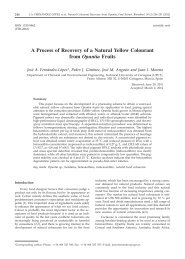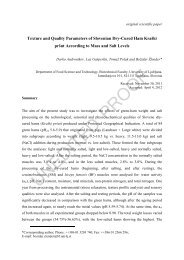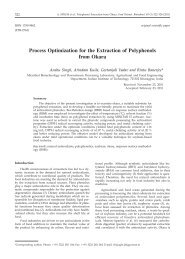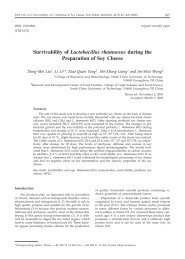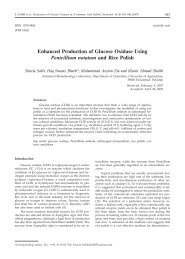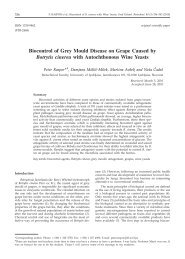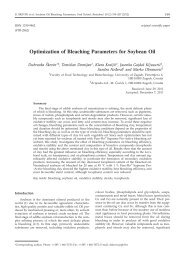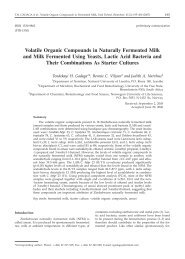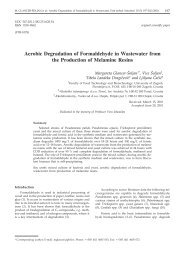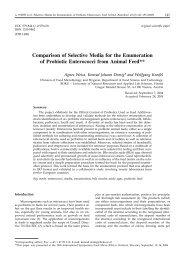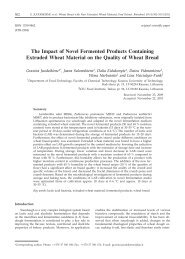Surfactin - Food Technology and Biotechnology
Surfactin - Food Technology and Biotechnology
Surfactin - Food Technology and Biotechnology
- No tags were found...
Create successful ePaper yourself
Turn your PDF publications into a flip-book with our unique Google optimized e-Paper software.
126 N.S. SHALIGRAM <strong>and</strong> R.S. SINGHAL: <strong>Surfactin</strong> – A Review, <strong>Food</strong> Technol. Biotechnol. 48 (2) 119–134 (2010)tration (UF) or nanofiltration (NF) processes. The brothwas pretreated by acid precipitation <strong>and</strong> then the precipitatewas dissolved in NaOH at pH=11. Experimentswere performed at different initial concentrations of surfactin(210–3620 mg/L), of added micelle-destabilizing solventethanol (0–44 %, by volume), membrane with molecularmass cut-off (MMCO) of 1–300 kDa, <strong>and</strong> differenttransmembrane pressures from 86.184·10 3 to 517.106·10 3Pa. It was found that in the tested concentration ranges,surfactin micelles could be efficiently destroyed whenmore than 33 % (by volume) ethanol was added to thebroth. The UF membranes with MMCO below 100 kDawere suitable for the retention of surfactin micelles, <strong>and</strong>the NF membrane with a MMCO lower than 1 kDa wassuitable for the retention of surfactin monomers. The separationstrategy involving two-stage membrane filtration(UF or NF) processes was proposed. After acid precipitation<strong>and</strong> centrifugation of the fermentation brothof B. subtilis ATCC 21332 culture, the precipitate was dissolvedin NaOH solution. A recovery of more than 97 %was obtained, but had a low purity of only 55 %.A single-stage batch UF experiments showed thatthe optimal conditions were a transmembrane pressureof 86.184·10 3 Pa, feed pH=7 <strong>and</strong> stirrer speed of 5 Hz(300 rpm). Of the UF membranes tested, the polyethersulphone(PES) membrane with a MMCO of 100 kDa(PES 100) gave an acceptable rejection of surfactin micelles(88 %), steady flux (e.g. 92.4 L/(m 2 /h) at a transmembranepressure of 86.184·10 3 Pa), <strong>and</strong> the retentateof high purity of about 75 %. Surfactant molecules associateto form micelles or vesicles at concentrations abovecritical micelle concentrations. This increases the moleculardiameter by two to three orders of magnitude ascompared to the single unassociated molecule. Thesesurfactin micelles could be destabilized to the form ofmonomers by adding 33 % (by volume) ethanol, whichwas allowed to effectively pass through the PES 100membrane. The use of two-stage UF process for improvedpurity of surfactin from the treated broth wasthus examined. Two-stage UF processes were proposedin two different routes. <strong>Surfactin</strong> was first retained byPES 100 membrane, <strong>and</strong> it was further purified by destabilizingthe surfactin micelles by adding 33 % (byvolume) ethanol. This route gave H-form of surfactinwith a purity of 85 % <strong>and</strong> total recovery yield of 87 %(at a feed surfactin concentration of 2054 mg/L). In anotherapproach, surfactin was first recovered as monomersin the permeate by PES 100 membrane, <strong>and</strong> smallermolecules such as salts were removed by the secondPES 100. This route gave H-form of surfactin with a purityof 83 % <strong>and</strong> total recovery yield of 72 %. These experimentsdemonstrated the promising application potentialof such two-stage UF processes for surfactinrecovery.In another variation, a two-step membrane filtrationprocess was evaluated using centrifugal <strong>and</strong> stirred celldevices, while the mechanisms of separation were investigatedby particle size <strong>and</strong> surface charge measurements(51). In the first step of ultrafiltration (UF-1),surfactin was retained effectively by membranes aboveits critical micelle concentration (CMC); subsequently inUF-2, the retentate micelles were disrupted by the additionof 50 % (by volume) methanol solution to allow recoveryof surfactin in the permeate. The main proteincontaminants were effectively retained by the membranein UF-2. UF was carried out either using centrifugal deviceswith 30- <strong>and</strong> 10-kDa MMCO regenerated cellulosemembranes, or a stirred cell device with 10-kDa MMCOPES <strong>and</strong> regenerated cellulose (RC) membranes. Totalrejection of surfactin was consistently observed in UF-1;while in UF-2, PES membranes had the lowest rejectioncoefficient of 0.08±0.04. UF rejection of micellar surfactinby a semi-porous membrane was achieved in the firststep, where surfactin was mainly purified from residualglucose <strong>and</strong> salts. In the second step, surfactin was purifiedessentially from proteins. PES membrane was foundto be more suitable for the purification of surfactin, especiallyin the second step of UF. The size <strong>and</strong> surfacecharge measurements demonstrated that disruption ofsurfactin micelles, aggregation of protein contaminants<strong>and</strong> electrostatic interactions between surfactin molecules<strong>and</strong> the membrane surface had a major influenceon its selective separation. One factor of concern in thesecond step of UF process was the effect of exposure ofUF membranes to a methanolic solution. It was foundthat the permeability of PES membranes reduced aftersubsequent exposure to 50 % (by volume) methanol solution.The process could be improved by choosing amembrane that is resistant to organic solvents. PES membraneswere found to be affected by concentration polarization,<strong>and</strong> therefore the need to purify surfactin usinga cross-flow filtration unit was suggested. This wouldundoubtedly be important in the scalability of this separationprocess.Chen et al. (52) also reported on the recovery of surfactinfrom the fermentation broths with culture of B. subtilisATCC 21332 by cross-flow ultrafiltration process. Thebroth was pretreated by acid precipitation, <strong>and</strong> the precipitatewas dissolved in NaOH. Two types of membranes,polyethersulphone (PES) <strong>and</strong> cellulose ester (CE),with MMCO of 100 kDa were implemented for the study.The effect of the presence of micelle-destabilizing solventethanol on the performance was studied. Experimentswere performed with initial concentrations of surfactinof 1.13–4.57 g/L, transmembrane pressures (TMP) of20–100 kPa, <strong>and</strong> cross-flow velocities of 0.16–0.48 m/s.The study indicated that the flux increased with increasingcross-flow velocity, but decreased with an increasein the initial surfactin concentration <strong>and</strong> TMP. Four cleaningagents <strong>and</strong> two cleaning methods (flushing <strong>and</strong> backflushing)were screened to recover the flux. To maximizethe reovery of surfactin, flushing with NaOH solution atpH=11 was suggested to clean the fouled PES membranein the cross-flow UF process. The optimal conditionsfor surfactin recovery were transmembrane pressureof 20–40 kPa <strong>and</strong> cross-flow velocity of 0.32 m/swith the feed concentration ranges of surfactin of 1.1–4.5g/L. The study suggested a flux decline during cross--flow UF with CE 100 <strong>and</strong> PES 100 membranes. Thiswas attributed to the concentration polarization as wellas weak adsorption of small amino acids, <strong>and</strong> the formationof gel layer on the membrane surface. Althoughthe recovery of surfactin with CE 100 (97 %) was foundto be higher than that with PES 100 (88 %), the latterwas recommended because of the gradual decline offlux. Destabilization of surfactin micelles by the addition




